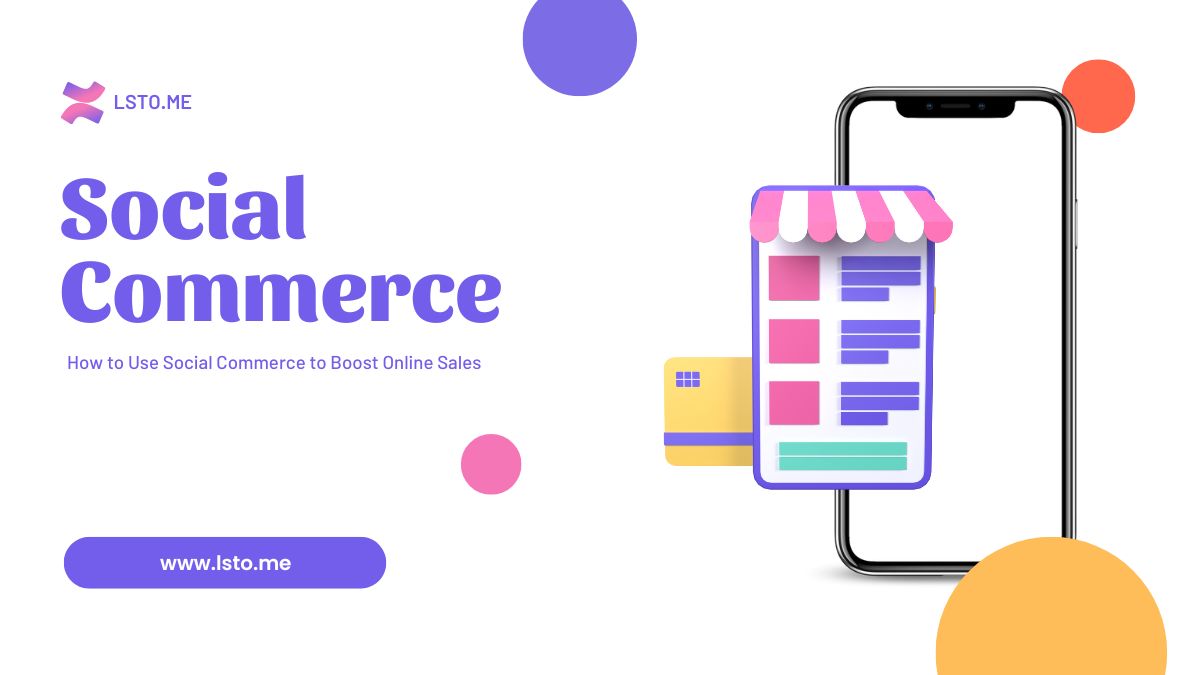
Social commerce is a major force in digital marketing. It is changing how businesses sell products online. As social media platforms evolve, they add shopping features. Users can browse, discover, and buy products within their favorite apps. For businesses, this is a chance to engage customers on social media, where they spend much of their time. This blog post will explore how to use social commerce to boost online sales. We’ll offer strategies and tips to maximize this growing trend.
What is Social Commerce?
Understanding the Basics
Social commerce is using social media to boost online sales. Unlike traditional e-commerce, social commerce doesn’t redirect users. It lets customers shop entirely within a social media platform. This mix of socializing and online shopping is more engaging and convenient for consumers.
The Rise of Social Commerce
Social commerce is growing. Several factors fuel this trend. People use social media more. Mobile technology has advanced. Shoppers want more personal, interactive experiences. Platforms like Facebook, Instagram, TikTok, and Pinterest have made it easier for businesses to sell on social media. They added shoppable posts, in-app checkout, and product tagging.
The Benefits of Social Commerce
Enhanced Customer Engagement
Social commerce allows businesses to connect with customers on a more personal level. By merging shopping with social interaction, brands can engage users. They can do this through comments, likes, shares, and direct messages. This fosters a sense of community and builds stronger relationships with their audience.
Example: A fashion brand can use Instagram Stories to showcase a new clothing line. It can encourage followers to swipe up to view and buy the items in the app. By responding to comments and DMs, the brand can engage with customers in real-time. It can answer questions and give personalized recommendations.
Streamlined Shopping Experience
A key advantage of social commerce is its ability to streamline shopping. Social commerce boosts conversion by reducing purchase steps. It minimizes friction. Customers can shop without leaving their favorite social media platform. This makes the experience more convenient and enjoyable.
Example: On Facebook, a business can create a shoppable post featuring a product with a “Buy Now” button. Clicking the button lets users buy within the Facebook app, so they won’t have to go to an external site.
Increased Brand Awareness and Reach
Social media platforms have vast, diverse user bases. They are ideal for raising brand awareness and reaching new customers. Social commerce lets businesses use social media’s viral nature. It can boost their brand and attract buyers. Hashtags, influencer partnerships, and user content can boost your brand’s reach.
Example: A skincare company can use influencers to promote its products on Instagram Reels. The company can create buzz and reach a wider audience. It should use a branded hashtag and ask followers to share their skincare routines.
Access to Rich Data and Insights
Social commerce platforms provide businesses with data on customers. It includes their behavior, preferences, and buying patterns. Use this info to improve marketing and optimize products. It should personalize the shopping experience for your audience.
Example: A home decor brand can analyze Pinterest analytics. It will show which products and styles are most popular with its followers. This data can guide future product and marketing efforts. It will help the brand meet customer demands.
Better Targeting and Personalization
Social media platforms have advanced targeting tools. They let businesses reach specific audiences based on demographics, interests, and behavior. Social commerce enhances shopping by personalizing it. Products and promotions are tailored to each user’s preferences and past interactions.
Example: A fitness brand can use Facebook’s targeting options. It can show personalized ads for workout gear to users who are interested in fitness content. Dynamic product ads can show users products they prefer.
Strategies for Boosting Online Sales with Social Commerce
Optimize Your Social Media Profiles for Shopping
The first step in social commerce is to optimize your social media profiles for shopping. Make sure your Instagram, Facebook, and Pinterest profiles are set as business accounts. Also, link them to your product catalog. This will allow you to create shoppable posts, product tags, and ads.
Tips:
- Use high-quality images and videos to showcase your products.
- Include clear calls-to-action (CTAs) such as “Shop Now” or “Learn More.”
- Regularly update your product catalog to reflect new arrivals and promotions.
- Use highlights on Instagram to showcase collections or bestsellers.
Create Engaging and Shoppable Content
Content is at the heart of social commerce. To boost sales, create engaging content. It should resonate with your audience and prompt action. Shoppable content, such as posts, stories, and videos, should be visually appealing, informative, and aligned with your brand’s messaging.
Tips:
- Use lifestyle imagery to show your products in use.
- Incorporate user-generated content (UGC) to build trust and authenticity.
- Utilize video content, such as tutorials, unboxings, and product demonstrations, to showcase your products in action.
- Experiment with interactive content, such as polls, quizzes, and AR filters, to engage your audience.
Leverage Influencer Partnerships
Influencer marketing is a powerful tool for driving social commerce. Working with influencers lets you access their loyal followers. You can use their credibility to promote your products. Influencers can make authentic, relatable content. It encourages their followers to buy.
Tips:
- Choose influencers whose audience aligns with your target market.
- Collaborate on content that feels natural and authentic to the influencer’s style.
- Use affiliate links or discount codes to track the performance of influencer campaigns.
- Encourage influencers to create shoppable content, such as Instagram posts or TikTok videos with product tags.
Utilize Social Media Ads
Paid ads on social media can effectively drive traffic to your social commerce sites. Facebook and Instagram offer many ad formats. They include shoppable ads, carousel ads, and dynamic product ads. These ads can help you reach your audience and boost conversions.
Tips:
- Use retargeting ads to reach users who have previously interacted with your brand.
- Create lookalike audiences to expand your reach to new potential customers.
- Test different ad creatives, such as images, videos, and carousels, to see what resonates best with your audience.
- Monitor ad performance regularly and adjust your targeting and creative strategies as needed.
Implement In-App Checkout
In-app checkout is a key feature of social commerce. It lets customers buy items without leaving the social media platform. In-app checkout streamlines buying, cuts cart abandonment, and improves shopping.
Tips:
- Enable in-app checkout on platforms like Instagram and Facebook if available in your region.
- Ensure that the checkout process is user-friendly and secure.
- Offer multiple payment options, such as credit cards, PayPal, and digital wallets, to accommodate different preferences.
- Provide clear and concise product descriptions, pricing, and shipping information.
Offer Exclusive Social Media Promotions
To boost social commerce sales, offer exclusive deals to your social media followers. Limited-time offers and flash sales create urgency. They encourage users to act.
Tips:
- Announce exclusive promotions in your social media posts, stories, and ads.
- Use countdown timers or other visual elements to emphasize the limited-time nature of the offer.
- Encourage followers to share the promotion with their friends and followers.
- Track the performance of each promotion to understand what drives the most sales.
Monitor and Optimize Your Social Commerce Strategy
Social commerce is a fast-changing field. So, you must monitor your initiatives and adjust them as needed. Use social media analytics tools to track key metrics. These include engagement, clicks, conversions, and revenue.
Tips:
- Set specific goals for your social commerce efforts, such as increasing sales, improving conversion rates, or growing your follower base.
- Analyze the performance of different types of content, promotions, and ad campaigns to identify what works best.
- Continuously experiment with new strategies and tactics to stay ahead of trends and changes in consumer behavior.
- Gather feedback from customers to understand their shopping experience and make improvements accordingly.
Conclusion
Social commerce is a powerful way for businesses to connect with customers. It enhances their shopping experience and drives online sales. Use social media’s unique features. Create engaging content. Use targeted strategies. You can boost your brand’s presence and revenue in the digital marketplace. As social commerce grows, staying ahead will be key to success. By following the tips in this post, you’ll harness social commerce for your business.




